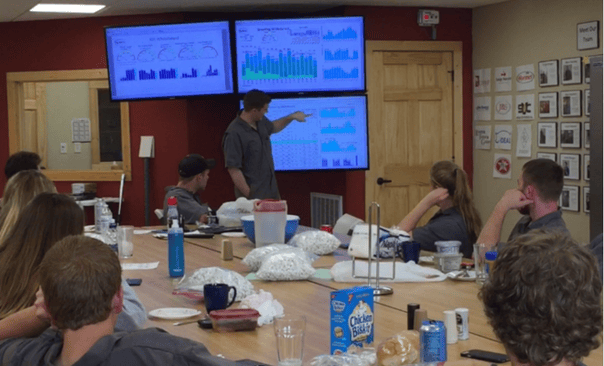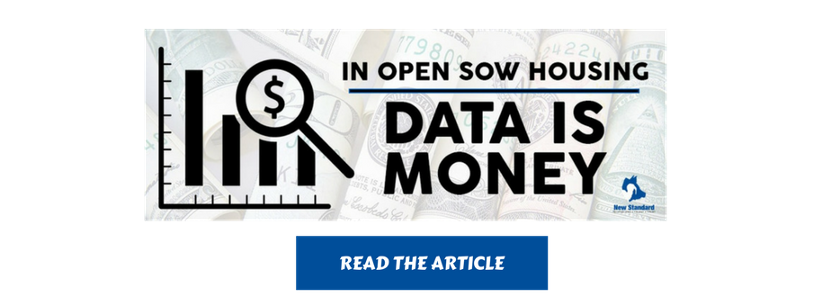
Learn how Kent Mogler and the staff at Pig Hill Farm in northwest Iowa have implemented data collection systems in their sow barn to help them make timely and accurate decisions.
Written by Kent Mogler of Mogler Farms
How We Collect Data in the Sow Pen
On our sow farm, we utilize a combination of PigChamp, Velos (Nedap ESF data) and AP controls to gather all the information we need to make well-educated decisions. With PigChamp, we use handheld devices to record some PigChamp activity, and we have installed computer and printer workstations throughout the barn. Thus, all data collection and reporting is accomplished “in the barn”. Our vision is that data is current (same day), accurate, and always focused on enabling the barn staff to be most successful and efficient.
Identifying Health Challenges Among Our Sows
Every day, we find each gestating animal that did not consume her feed budget and conduct a health and treatment assessment. Before we begin daily pen chores, we look at the daily pen feed consumption which can quickly tell us when health challenges are arising by the amount of feed remaining in the pen’s allotted feed budget. This increases our attentiveness to health observation as we perform pen chores.
Another win we had after implementing electronic sow feeders and the Velos software was getting the proper feed plan to each animal by integrating Body Condition Scoring into each plan. With this system in place, sows coming into farrowing are extremely uniform and properly conditioned for a successful farrow event.
New Processes with a New Hog Barn Design
We believe the concepts in the Four Disciplines of Execution (McChesney) are very applicable in systems management, and we continue to refine our application of these 4 disciplines (4DX) which are:
- Know your wildly important goal(s) – WIGs
- Have a good lag indicator and a great lead indicator for each WIG
- Have a compelling scoreboard
- Implement a cadence of accountability
We are very focused on the elimination of the eight deadly wastes from lean manufacturing. Computer systems can easily add a lot of waste like: waiting, redundancy, correction of data, etc. Computer systems often do not provide the efficiency benefits we were hoping for. We have put focus on making our “computer and data entry time” significantly less.
Improving Efficiency Through Auto-Generated Lists
In order to cut down on waste, we have programmed our software to automate and print a few different daily lists. The first list is the ESF "Non-Eater." This report not only tells us who hasn't eaten, but also gives us each sow's most recent marking or status. This allows our staff to easily and efficiently identify, check, and treat the animals in the large group gestation pens.
Another example is our vaccination and pregnancy check events. Two days prior to the tasks, we are able to tell the system to mark (paint) each sow a color according to the task that will take place. On the day of the task, instead of having to take the time to set a parameter and print the list, it is printed and waiting for our staff to use.

Chet Mogler reviewing the daily scoreboard with the Pig Hill staff.
Keeping an Up-To-Date Scoreboard
Can you imagine walking into a basketball arena without a scoreboard? Or making investments in companies with no access to current stock market prices? In applying the 4DX, we also are passionate about having a timely and accurate scoreboard which is visible to all staff.
As we’ve evolved, our data has become more timely and accurate because we publish a daily scoreboard directly from the system. We now publish a breeding, farrowing and nursery scoreboard that has today’s results. It automatically updates directly from the PigChamp and Velos systems so we don’t waste time “updating, running, reviewing, correcting and printing” reports. This operating practice improves data timeliness and accuracy within the system (a cadence of accountability) and all reports become more reliable, timely and useful. The challenging part comes in prioritizing your needs, integrating data across systems and keeping the data infrastructure simple and easy to support.
The Bottom Line
With a combination of all our data systems, we have been able to make sound financial decisions. We continue to look for ways to further improve efficiency, accuracy and timeliness of all data. We also expect that all data system providers will integrate more efficiently, improve data accessibility across systems and increase their focus on front-line employee use.






